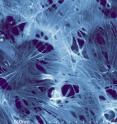Paperwork: Buckypapers clarify electrical, optical behavior of nanotubes
Using highly uniform samples of carbon nanotubes—sorted by centrifuge for length—materials scientists at the National Institute of Standards and Technology (NIST) have made some of the most precise measurements yet of the concentrations at which delicate mats of nanotubes become transparent, conducting sheets. Their recent experiments* point up the importance of using relatively homogeneous—not overly short, but uniform in length— nanotubes for making high performance conducting films. Among their other qualities, single-wall carbon nanotubes (SWCNTs) have attracted much attention as tiny electrical conductors. Relatively small concentrations of nanotubes can change a normally insulating polymer film to a transparent electrical conductor. Potential applications range from transparent electrical shielding materials to futuristic flexible video displays, thin-film chemical sensors and other foldable electronics. One key design parameter for conductive films is the so-called “percolation threshold”—essentially the concentration at which random two- or three-dimensional networks of nanotubes first become electrically conducting.
To test theories on how both the conductance and optical properties of such nanotube-infused films depend on the length of the tubes, the NIST team made samples of “buckypaper” by mixing nanotubes in water and draining the water away through nanoscale filters to leave behind a delicate nanotube mat. The highly refined, length-sorted nanotube samples were produced by an efficient technique developed earlier by the NIST group (see “Spin Control: New Technique Sorts Nanotubes by Length”).
The NIST measurements validated one theory: buckypaper made of length-sorted carbon nanotubes closely follows the percolation theory for ideal two-dimensional sheets, with concentration threshold for conductivity getting lower as the tubes get longer. A sheet of 820 nanometer long nanotubes becomes conducting at an amazingly low 18 nanograms per square centimeter, the lowest yet reported. Interestingly, batches of short nanotubes or mixed-length batches form more three-dimensional networks that perform noticeably worse. On the other hand, predictions that optically the sheets would behave like thin metallic films turn out not to be the case. Optical properties are better predicted by the same general percolation theory, say the NIST researchers, which will provide a convenient theoretical framework for designing and engineering nanotech applications with these materials.
Source: National Institute of Standards and Technology (NIST)
Other sources
- Paperwork: Buckypapers Clarify Electrical, Optical Behavior of Nanotubesfrom PhysorgWed, 15 Oct 2008, 19:28:13 UTC
